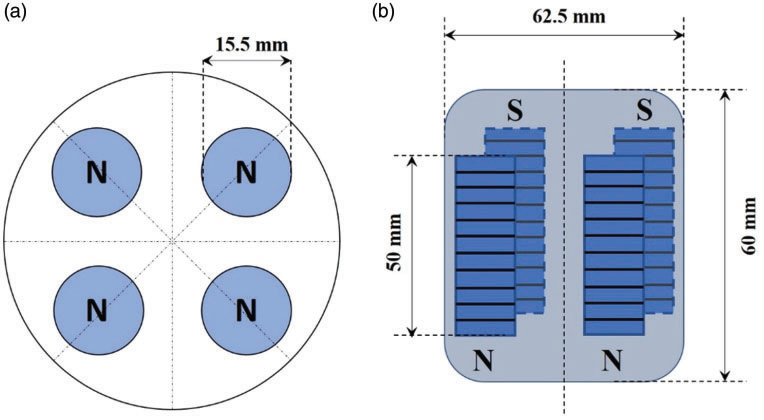The present experimental investigation attempts to understand and address the effect of ultrasonic vibrations on material removal in the polishing of silicon wafers (1 0 0). The requisite finishing experimentations were performed on an indigenously developed experimental arrangement of double-disc chemical assisted magnetorheological finishing (DDCAMRF) process with longitudinal vibrations. The MR fluid used in the experiments consists of a water-based suspension prepared by mixing suitable amounts of carbonyl iron particles (CIPs), abrasive particles, and additives or stabilizers. The prepared MR fluid uses both mechanics and chemistry to finish the silicon surface. Mechanics is mainly responsible for micro-scratching of silicon surface, which gets “softened” by hydration utilizing DI water in the MR fluid. In this study, the ‘response surface methodology (RSM)’ was chosen for designing the experiments to evaluate the significance of different process factors, namely polishing speed, abrasive concentration, and ultrasonic power on the material removal rate (MRR) in DDCAMRF process. The material removed from the wafer surface was measured using the precision digital weighing balance. It was observed that the MRR was found to increase with the increase in various process factors used. Further, analysis of variance (i.e., ANOVA) technique with a 95% confidence interval was performed to analyze the significant contribution of different process factors on MRR. The validation of developed model was done by performing experiments on random and optimized set of process factors. From, the statistical investigation it was discovered that ultrasonic power has highest contribution of 57.9% on MRR, followed by the polishing speed (13.3%), and abrasive concentration (12.5%). Furthermore, a genetic algorithm optimization tool was utilized to obtain optimum set of process parameters to maximize MRR.
Several brittle materials like silicon wafers, optical glass, etc. are in demand for various high-tech industries like optical, microelectronics, solar-based, etc.1 The surface quality of such materials plays a very crucial role in affecting the efficiency of different manufactured components. To produce defect-free and finished surfaces, several superfinishing processes have been developed, which are capable of finishing such brittle materials. As an excellent semiconductor material, monocrystalline silicon has widely been used to manufacture different electronic components (viz. MOSFET, transistors, microprocessors, integrated circuits, etc.). Also, silicon’s excellent electrical and mechanical properties makes it an integral part of microelectromechanical (MEMS) systems such as microsensors, biosensors, microvalves, and so on. Polishing the surfaces of such materials utilizing traditional/conventional techniques like grinding, honing, and lapping generally resulted in residual stresses, surface, and sub-surface damage. Such techniques are incapable of achieving the desired finishing quality on the surface of brittle materials like silicon wafers. In the recent past, several kinds of research have been made to polish such brittle materials.
A magnetic disc with four poles having permanent magnets arranged, as shown in Figure 1, has been used in the present study. Magnetic discs were made utilizing the stainless steel as a casing material (SS- 304) having four blind holes in them. A stack of fifteen small permanent magnetic discs (NdFeB 35, 15 mm x3 mm thick) was placed inside each blind hole. The magnetic discs were placed in such a manner that they form a magnetic tool with four poles arranged as shown in Figure 2. The arrangement of placing the magnetic discs on both side of the workpiece was selected after performing several trials incorporating different number of poles, which further ensures a perfectly synchronous motion of the upper and lower set of magnetic discs.

Fig1
The magnetic force applied by the MR fluid brush within the polishing region is primarily due to the applied magnetic field, by the strength of permanent magnets used. The magnetic force acting on the CIP particles depends mainly on the applied magnetic field and its gradient present within the finishing region. The magnetic field strength in the finishing region is one of the important factors which is of utmost importance while carrying out polishing. With the intensity being too high in the polishing region, it may result into forming a rigid brush due to which higher magnetic force acts on the surface. However, as the intensity becomes too low, the MR fluid brush will not be able to finish due to the breaking of CIP chains.
Firstly, concentrating the iron particles within the polishing region and thus helps in preventing the splashing of MR fluid due to the rotational motion of upper magnetic disc. Secondly, it causes the indentation of abrasive particles into the workpiece top surface, which increases the normal force (FN) acting on the iron particles, thus transmitting it to the work surface. The rotation of upper magnetic disc, in turn, rotates the MR fluid kept between the polishing region, thus exerting a tangential cutting force (FTC), which helps in removing the material in the form of micro or nano-sized chips from the workpiece surface, as shown in Figure 7.
上一篇: 半导体晶圆热扩散系数测量的光热偏转方法
下一篇: 锗(Ge)晶圆清洗液开发